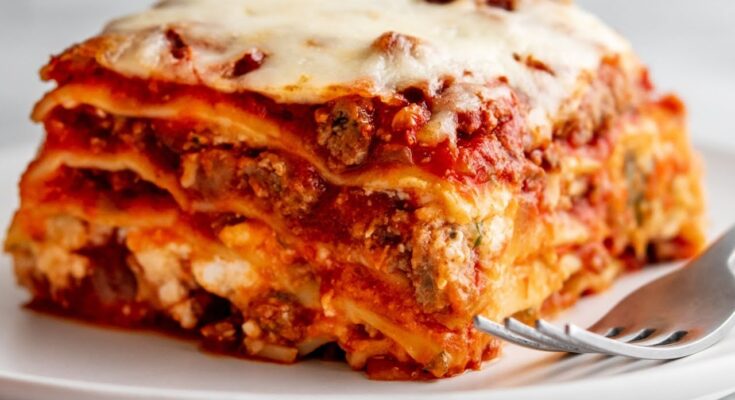Lasagne Cottage Cheese Recipe: Lasagne is one of those timeless comfort foods that can turn any dinner into a feast. But what if you swapped out the traditional ricotta cheese for cottage cheese? You’d get a lasagne that’s lighter, creamier, and packed with protein—without losing the delicious, layered goodness we all crave.
This recipe will walk you through everything from the ingredients to the baking process, with plenty of tips to make sure your dish comes out bubbling, golden, and utterly irresistible.
Introduction to Cottage Cheese Lasagne
Lasagne has been a family favorite for centuries, often served at Sunday dinners, holidays, or whenever a hearty meal is needed. Traditionally, ricotta or béchamel is used to create creamy layers. However, swapping it with cottage cheese creates a unique balance—it’s lighter, healthier, and slightly tangier.
Why Choose Cottage Cheese Over Ricotta?
Many people choose cottage cheese because it’s lower in fat and calories compared to ricotta, but still provides a creamy texture. Plus, cottage cheese is packed with protein, making your lasagne not just delicious but also more nutritious. It also tends to blend better with herbs and spices, giving your lasagne an extra depth of flavor.
A Comfort Dish With a Twist
This cottage cheese lasagne isn’t just a substitution recipe—it’s a reinvention. By combining savory meat sauce, tender lasagne noodles, gooey melted mozzarella, and a creamy cottage cheese filling, you’ll get a dish that feels indulgent but still wholesome. It’s the kind of recipe that wins over both kids and adults alike.
Ingredients You’ll Need
Before we dive into the step-by-step cooking guide, let’s gather everything you’ll need. Having your ingredients measured and ready makes the cooking process smoother and more enjoyable.
Core Ingredients for Lasagne Layers
- 12 lasagne noodles (regular or oven-ready)
- 1 pound ground beef (or ground turkey for a lighter version)
- 1 jar (24 oz) marinara sauce or homemade pasta sauce
- 2 cups shredded mozzarella cheese
Sauce Ingredients for Rich Flavor
- 1 medium onion, finely chopped
- 3 garlic cloves, minced
- 2 tablespoons olive oil
- 1 teaspoon Italian seasoning (oregano, basil, thyme blend)
- 1 teaspoon salt and ½ teaspoon black pepper
- ½ teaspoon red pepper flakes (optional, for spice)
Cheese Blend for a Creamy Finish
- 2 cups cottage cheese
- 1 large egg (for binding)
- ½ cup grated Parmesan cheese
- 2 tablespoons fresh parsley, chopped
Optional Add-ons for Customization
- Spinach or kale (for extra greens)
- Mushrooms (for earthy flavor)
- Zucchini slices (for a veggie-loaded version)
- Extra cheese like provolone or gouda for richness
Kitchen Tools and Equipment Required
A good recipe needs the right tools. You don’t want to be halfway through layering your lasagne only to realize you’re missing a crucial item.
Essential Cooking Utensils
- Large skillet or frying pan (for cooking the meat sauce)
- Medium mixing bowls (for cheese mixture and prep work)
- Wooden spoon or spatula
- Measuring cups and spoons
Baking Essentials for Perfect Lasagne
- 9×13-inch baking dish
- Aluminum foil (to cover while baking)
- Oven mitts
- Sharp knife for slicing
Having these essentials at hand makes the entire process smoother and ensures your lasagne bakes evenly with the perfect golden crust.
Step-by-Step Guide to Making Cottage Cheese Lasagne
Now that you have everything ready, let’s dive into the fun part—cooking! Making lasagne might look complicated, but once you break it down step by step, it’s surprisingly simple.
Step 1 – Preparing the Meat Sauce
Start by heating olive oil in a large skillet over medium heat. Add chopped onions and garlic, sautéing until fragrant and golden. Add the ground beef (or turkey) and cook until browned. Season with Italian seasoning, salt, pepper, and red pepper flakes if you like a little heat. Once the meat is fully cooked, pour in your marinara sauce and let it simmer for 15–20 minutes. This helps the flavors meld together, creating a rich, savory base for your lasagne.
Step 2 – Making the Cottage Cheese Mixture
In a medium mixing bowl, combine cottage cheese, Parmesan cheese, parsley, and the egg. The egg helps bind the mixture so it doesn’t become too runny during baking. Stir until well combined. This creamy filling will add layers of flavor and texture to your lasagne.
Step 3 – Cooking and Preparing Lasagne Noodles
Lasagne noodles are the foundation of your dish, so handling them properly is key. If you’re using regular lasagne noodles, bring a large pot of salted water to a rolling boil. Add the noodles carefully, one at a time, to prevent sticking. Stir occasionally and cook according to the package directions until al dente (firm but not hard). Overcooking them will make the lasagne mushy once baked.
Once cooked, drain the noodles and lay them flat on a clean kitchen towel or parchment paper to prevent them from clumping together. If you’re using oven-ready noodles, you can skip this step. However, many chefs still recommend soaking them in warm water for 10 minutes before layering. This softens them slightly and ensures they bake evenly with the sauce.
Taking a little extra care here makes a huge difference in the final dish. Perfectly cooked noodles act as sturdy layers that hold the rich sauce and creamy cheese mixture together.
Step 4 – Layering the Lasagne Properly
Layering is where your lasagne truly takes shape, and it’s almost like building a delicious tower. Here’s the order for foolproof results:
- Start with a thin layer of meat sauce at the bottom of your greased baking dish. This prevents the noodles from sticking.
- Lay down your first layer of noodles, slightly overlapping them.
- Spread a generous portion of the cottage cheese mixture over the noodles. Use a spoon or spatula to make an even layer.
- Add a layer of meat sauce, ensuring the noodles are fully covered.
- Sprinkle mozzarella cheese generously over the top.
- Repeat layers until you reach the top of the dish, usually three layers deep.
Finish with a final layer of noodles, sauce, and a generous topping of mozzarella and Parmesan. This top layer will form the golden-brown crust that makes lasagne irresistible.
Step 5 – Baking to Perfection
Preheat your oven to 375°F (190°C). Cover your lasagne with aluminum foil to prevent the top from burning while still allowing it to bake evenly. Bake for 25–30 minutes covered. Then, remove the foil and bake for an additional 15–20 minutes until the cheese is bubbling and golden brown.
Once done, resist the temptation to cut right in. Let your lasagne rest for at least 10–15 minutes before slicing. This helps the layers set and makes serving much easier. Trust me, the wait is worth it—your slices will hold their shape beautifully, and the flavors will have time to meld together perfectly.
Serving Suggestions
Lasagne on its own is hearty enough to be a complete meal, but the right side dishes can elevate it into a restaurant-style experience at home.
Pairing with Side Dishes
- Garlic Bread: Warm, buttery garlic bread is a classic companion. It’s perfect for soaking up extra sauce.
- Fresh Salad: A crisp Caesar salad or a simple garden salad with vinaigrette balances the richness of the lasagne.
- Roasted Vegetables: Seasonal vegetables like zucchini, bell peppers, or asparagus make a colorful and healthy addition.
Best Wine and Beverage Pairings
For beverages, a medium-bodied red wine like Chianti or Merlot pairs beautifully with the savory flavors of lasagne. If you prefer non-alcoholic options, sparkling water with lemon or a chilled iced tea works just as well to cleanse the palate.
Tips and Tricks for the Perfect Lasagne
Even the best recipes can sometimes go wrong without a few insider tips. Here’s how to guarantee your lasagne comes out perfect every single time:
How to Keep Lasagne from Getting Watery
Watery lasagne is a common frustration. To avoid it:
- Drain the cottage cheese slightly before mixing.
- Simmer the meat sauce long enough to thicken.
- Allow the lasagne to rest after baking.
Making it Ahead of Time
Lasagne is an excellent make-ahead dish. You can prepare it up to 24 hours before baking. Simply assemble it, cover tightly with foil, and refrigerate. When ready, bake it straight from the fridge, adding an extra 10–15 minutes to the cooking time.
This trick is especially helpful for busy weeknights or dinner parties—you get all the flavor with none of the last-minute stress.
Variations of Cottage Cheese Lasagne
Lasagne is one of those recipes that can be endlessly customized. The cottage cheese version already adds a unique twist, but you can go even further by tailoring it to different dietary preferences and flavors.
Vegetarian Cottage Cheese Lasagne
If you’d like to skip the meat, this variation is just as hearty. Replace the ground beef with layers of sautéed vegetables such as mushrooms, zucchini, spinach, and bell peppers. You can even add roasted eggplant for a rich, smoky flavor. The cottage cheese mixture pairs beautifully with these veggies, creating a wholesome, meat-free dish that doesn’t compromise on flavor.
Low-Carb or Keto-Friendly Version
For those cutting down on carbs, traditional lasagne noodles can be replaced with zucchini slices or thin eggplant strips. Simply slice them lengthwise, lightly salt them to draw out excess water, and roast before layering. These veggie “noodles” not only keep the dish low in carbs but also add extra nutrients and a unique texture.
Gluten-Free Adaptation
If you’re gluten-sensitive, you can easily make lasagne with gluten-free pasta available at most supermarkets. Another option is to use brown rice or chickpea lasagne noodles, which give the dish a nutty, wholesome flavor while keeping it friendly for gluten-free diets.
Storing and Reheating Instructions
Lasagne often tastes even better the next day because the flavors have more time to blend. But storing and reheating it properly is key to keeping it just as delicious.
Refrigerating Leftovers Safely
Cool the lasagne completely before storing. Cut it into portions and place them in airtight containers. It will keep well in the refrigerator for up to 4–5 days.
Freezing for Long-Term Storage
Lasagne freezes beautifully. You can freeze it before baking (as a make-ahead meal) or after baking (for leftovers). Wrap the dish tightly with plastic wrap and foil, or use freezer-safe containers. It will stay fresh for up to 2–3 months.
Reheating Without Losing Flavor
To reheat refrigerated lasagne, cover it with foil and warm it in the oven at 350°F (175°C) for about 20–25 minutes. For frozen lasagne, thaw overnight in the fridge before reheating. Avoid microwaving large portions, as it can make the noodles rubbery—though reheating individual slices in the microwave works fine for a quick meal.
Nutritional Value of Cottage Cheese Lasagne
Swapping ricotta with cottage cheese not only changes the texture but also the nutritional profile.
Protein Benefits from Cottage Cheese
Cottage cheese is an excellent source of protein, making this lasagne a more filling and muscle-friendly meal. A single serving of cottage cheese can contain up to 12–14 grams of protein, which helps balance out the carbs from the pasta.
Calorie and Carbohydrate Breakdown
On average, one serving of cottage cheese lasagne (about 1/8 of a standard dish) provides:
- Calories: 350–450 (depending on ingredients)
- Protein: 20–25g
- Carbs: 30–35g
- Fat: 12–18g
This makes it a satisfying, balanced meal that can be enjoyed guilt-free when paired with lighter sides like salad or vegetables.
Common Mistakes to Avoid
Even seasoned cooks sometimes slip up with lasagne. Here are a few pitfalls and how to steer clear of them.
Overcooking the Pasta
One of the biggest mistakes is cooking lasagne noodles too long. Remember, they will continue to cook while baking in the oven. Keep them slightly undercooked when boiling to ensure the perfect bite after baking.
Not Draining the Cheese Properly
Cottage cheese contains more moisture than ricotta. If not drained or combined properly, it can lead to watery lasagne. To fix this, strain the cottage cheese for 10–15 minutes before mixing or blend it slightly for a creamier texture.
By avoiding these mistakes, you’ll end up with a lasagne that’s firm, flavorful, and holds together beautifully on the plate.
FAQs about Lasagne Cottage Cheese Recipe
Q1: Can I use cottage cheese and ricotta together?
Yes! Mixing the two gives you the best of both worlds—ricotta’s creaminess with cottage cheese’s light texture and protein boost.
Q2: Can I make lasagne without meat?
Absolutely. Replace meat with veggies or even lentils for a hearty vegetarian version.
Q3: How long should I let lasagne rest before cutting?
At least 10–15 minutes. This helps the layers set and prevents the cheese from spilling out.
Q4: Can I prepare lasagne in advance?
Yes, you can assemble it a day before, refrigerate it, and bake when ready. Just increase baking time slightly.
Q5: What’s the best way to freeze lasagne?
Wrap tightly with plastic wrap and foil, or use a freezer-safe container. Thaw overnight before reheating for the best texture.
Conclusion
Cottage cheese lasagne is proof that comfort food can be both satisfying and healthy. By swapping out ricotta with cottage cheese, you add a lighter, protein-rich twist without losing the creamy, cheesy layers everyone loves. Whether you stick with the classic version or try a vegetarian, gluten-free, or low-carb adaptation, this recipe is versatile enough to suit any table. With the right layering technique, storage tips, and cooking tricks, your homemade lasagne will rival any restaurant dish.
So, next time you’re craving comfort food, skip the takeout and whip up this cottage cheese lasagne—you’ll have a bubbling, golden masterpiece that brings everyone to the table with smiles.



